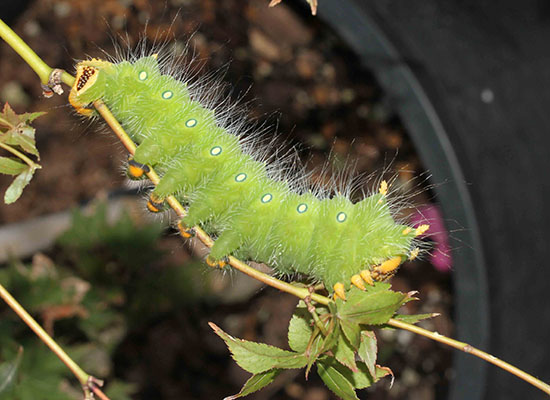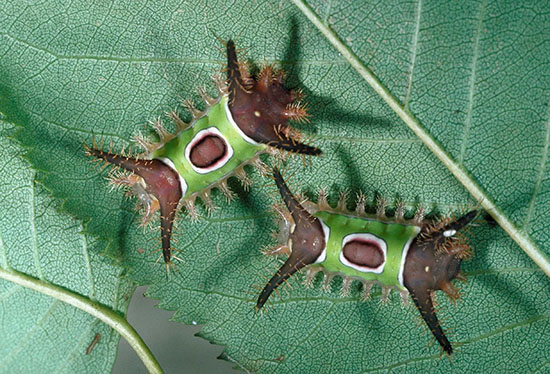Issue 15, September 11, 2017
Stinging Caterpillars
Almost all caterpillars are harmless when handled, their impact to us is primarily from their feeding on plants. A few caterpillars possess stinging hairs and barbs that cause various reactions from itchy rashes to painful stings. They are easily recognized by their physical appearance, being colorful with obvious hairs and spines. These include the Io, imperial, and saddleback caterpillars.
Io moth, Automeris io, caterpillars are gregarious (feed in groups) and grow to 3 inches; they are light green, with a white stripe bordered in dark red. Tufts of irritating spines on their back are connected to poison glands. Small, young caterpillars are orange, with gray bristles. People who contact the spines often react as if stung; itching may be mild or severe. The caterpillar feeds on trees and shrubs, including ash, beech, birch, elm, linden, maple, oak, poplar, rose, sycamore, and willow. They eventually spin a thin, papery cocoon that falls to the ground. Hindwings of adults have conspicuous eyespots. Adult female moths are attracted to outdoor lighting and lay eggs in clusters on leaf undersides. There is generally one generation per year in Illinois.

Io moth caterpillar.
Imperial moth, Eacles imperialis, caterpillars become large, up to 4 inches. They are covered with long, irritating hairs; people are more likely to react with an itching rash rather than a stinging sensation. They are green, with four large and four small hornlike yellow to orange tubercles behind the head and a couple of median, yellow to orange, short, cone-shaped tubercles towards the back end. These caterpillars feed on many trees, including oak, maple, linden, birch, elm, walnut, cedar, and pine. They form naked pupae (without a silk cocoon) in the soil or leaf litter. Adult moths are bright yellow, with brownish markings and wingspans from 3-1/2 to 5-1/2 inches.

Imperial moth larva on Japanese maple.
Saddleback caterpillar, Sibine stimulea, is greenish, with a brown, oval saddleback marking on the back. Also, it has distinctive stinging spines or hairs that, when touched, can severely irritate the skin. The caterpillars grow to about 1 inch and primarily feed on rose, cherry, and pawpaw. An adult moth is dark brown, with two small white spots on each forewing.

Saddleback caterpillars.
Saddleback caterpillar is in the family of slug caterpillars, having no obvious legs as larvae. Several others in the same family also have stinging spines and are colorful with orange and red being common. They feed primarily on the leaves of forest trees and are very rare in landscapes, even when the same tree species are present. It is useful for foresters to acquaint themselves with these other species.
Although these caterpillars, particularly the large ones, eat large quantities of leaves, the female moths typically scatter their eggs. This pattern results in only local defoliation. In some years, however, caterpillars can be locally numerous, with very noticeable defoliation. Io moths lay egg clusters, resulting in gregarious caterpillars that are more likely to cause damage. Even so, this late-season, occasional defoliation does not seriously harm the tree's health. (Phil Nixon)
Author:
Phil Nixon